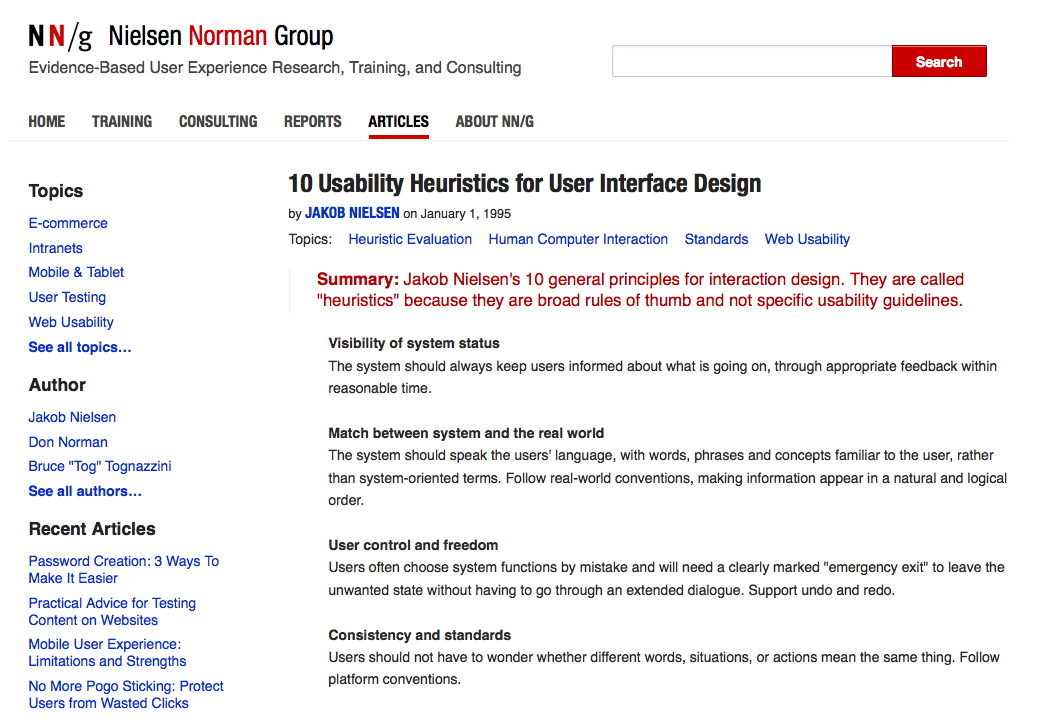The article 10 Heuristics for User Interface Design by Jakob Nielsen provides a convenient checklist of 10 key things/features/factors that any usable website should have. It is worth running through this as a design review for any user-facing project that you are composing, or that you are reviewing from others.
-
Visibility of system status
-
The system should always keep users informed about what is going on, through appropriate feedback within reasonable time.
-
Match between system and the real world
-
The system should speak the users’ language, with words, phrases and concepts familiar to the user, rather than system-oriented terms. Follow real-world conventions, making information appear in a natural and logical order.
-
User control and freedom
-
Users often choose system functions by mistake and will need a clearly marked “emergency exit” to leave the unwanted state without having to go through an extended dialogue. Support undo and redo.
-
Consistency and standards
-
Users should not have to wonder whether different words, situations, or actions mean the same thing. Follow platform conventions.
-
Error prevention
-
Even better than good error messages is a careful design which prevents a problem from occurring in the first place. Either eliminate error-prone conditions or check for them and present users with a confirmation option before they commit to the action.
-
Recognition rather than recall
-
Minimize the user’s memory load by making objects, actions, and options visible. The user should not have to remember information from one part of the dialogue to another. Instructions for use of the system should be visible or easily retrievable whenever appropriate. (Read full article on recognition vs. recall in UX.)
-
Flexibility and efficiency of use
-
Accelerators — unseen by the novice user — may often speed up the interaction for the expert user such that the system can cater to both inexperienced and experienced users. Allow users to tailor frequent actions.
-
Aesthetic and minimalist design
-
Dialogues should not contain information which is irrelevant or rarely needed. Every extra unit of information in a dialogue competes with the relevant units of information and diminishes their relative visibility.
-
Help users recognize, diagnose, and recover from errors
-
Error messages should be expressed in plain language (no codes), precisely indicate the problem, and constructively suggest a solution.
-
Help and documentation
-
Even though it is better if the system can be used without documentation, it may be necessary to provide help and documentation. Any such information should be easy to search, focused on the user’s task, list concrete steps to be carried out, and not be too large.
I originally developed the heuristics for heuristic evaluation in collaboration with Rolf Molich in 1990 [Molich and Nielsen 1990; Nielsen and Molich 1990]. I since refined the heuristics based on a factor analysis of 249 usability problems [Nielsen 1994a] to derive a set of heuristics with maximum explanatory power, resulting in this revised set of heuristics [Nielsen 1994b].
See Also:
- Bruce “Tog” Tognazzini’s list of basic principles for interface design. The list is slightly too long for heuristic evaluation but serves as a useful checklist.
- Examples of the 10 heuristics in Web applications.
- The 10 usability heuristics applied to everyday life (just for fun).
- Full set of 2,397 usability guidelines (across multiple reports).
References
-
Molich, R., and Nielsen, J. (1990). Improving a human-computer dialogue, Communications of the ACM 33 , 3 (March), 338-348.
-
Nielsen, J., and Molich, R. (1990). Heuristic evaluation of user interfaces, Proc. ACM CHI’90 Conf. (Seattle, WA, 1-5 April), 249-256.
-
Nielsen, J. (1994a). Enhancing the explanatory power of usability heuristics. Proc. ACM CHI’94 Conf. (Boston, MA, April 24-28), 152-158.
-
Nielsen, J. (1994b). Heuristic evaluation. In Nielsen, J., and Mack, R.L. (Eds.), Usability Inspection Methods, John Wiley & Sons, New York, NY.
